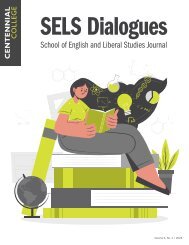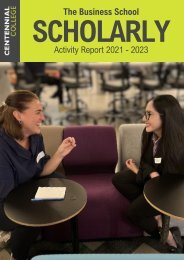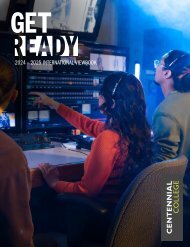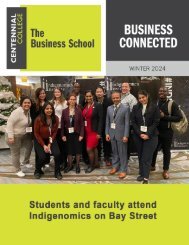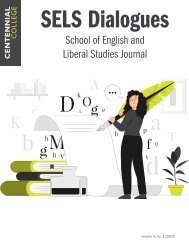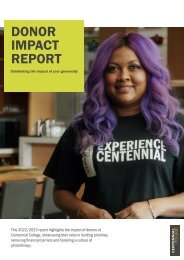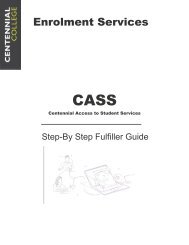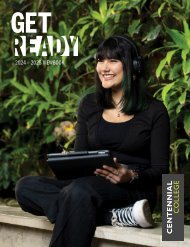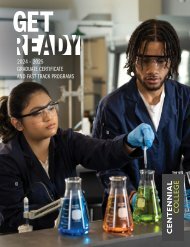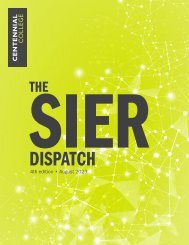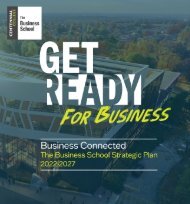The Teaching and Learning Innovation Digest - May 2023
Welcome to a truly special edition of the Teaching and Learning Innovation Digest! Our seventh annual academic publication has assumed an incredibly meaningful shape and form for a number of reasons. Not only did we receive an enthusiastic response with over 30 submissions via our institutional broadcast, but we also have consciously and intentionally embraced the principles of Universal Design for Learning by attempting to represent and celebrate the varied forms of expressions therein. From reflective essays, poetry, visual and performing arts, podcasts, video conversations to scholarly work, academic and applied research, news and updates, and interviews, this is truly a power-packed publication!
Welcome to a truly special edition of the Teaching and Learning Innovation Digest! Our seventh annual academic publication has assumed an incredibly meaningful shape and form for a number of reasons. Not only did we receive an enthusiastic response with over 30 submissions via our institutional broadcast, but we also have consciously and intentionally embraced the principles of Universal Design for Learning by attempting to represent and celebrate the varied forms of expressions therein. From reflective essays, poetry, visual and performing arts, podcasts, video conversations to scholarly work, academic and applied research, news and updates, and interviews, this is truly a power-packed publication!
You also want an ePaper? Increase the reach of your titles
YUMPU automatically turns print PDFs into web optimized ePapers that Google loves.
<strong>The</strong> stress of a p<strong>and</strong>emic<br />
<strong>The</strong> COVID-19 p<strong>and</strong>emic was stressful, for<br />
many even traumatic. All of us, no matter<br />
where we reside, experienced some level of<br />
complex <strong>and</strong> multilayered stress that impacted<br />
us in multiple <strong>and</strong> profound ways.<br />
Uncertainty, uneasiness, <strong>and</strong> fear eroded that<br />
sense of community many of us had built in<br />
both our personal <strong>and</strong> professional lives.<br />
Most of us were forced to isolate, which<br />
meant a troubling increase in screen time<br />
whether for work, school, <strong>and</strong>/or social<br />
activities. Masks were m<strong>and</strong>ated, further<br />
heightening our growing anxiety. Words like<br />
social distancing, vaccine m<strong>and</strong>ates, hesitancy,<br />
<strong>and</strong> self-care became part of our everyday<br />
vocabulary. All the while people were managing<br />
incredibly stressful events like losing their<br />
livelihood, experiencing violence, addictions,<br />
<strong>and</strong> mental health crises.<br />
Hospitalization rates soared with many<br />
dying devoid of the company of loved<br />
ones. <strong>The</strong> thought of returning to campus<br />
amidst, or after this level of chaos, was <strong>and</strong> still<br />
is stressful.<br />
Despite the stress <strong>and</strong> chaos, we had to show<br />
up; it was business as usual. But was it?<br />
<strong>The</strong> trauma of society seeped into our virtual<br />
<strong>and</strong> physical classrooms with many students<br />
unable to make it to class because they were<br />
caught up in this chaos. For some the chaos<br />
is ongoing, a bad dream that doesn’t seem to<br />
TEACHING FROM THE<br />
HEART<br />
Rachel Larabee<br />
Faculty, Commmunity Development Worker Program,<br />
School of Community <strong>and</strong> Health Studies (SCHS)<br />
end. I found myself asking how do I continue,<br />
particularly when I felt bereft of my support<br />
systems, that community of colleagues who<br />
supported one another when it was business<br />
as usual. Those communal spaces at the<br />
college where we laughed, vented, <strong>and</strong> even<br />
cried together, were no longer there. How could<br />
we support each other so that we could fully<br />
show up <strong>and</strong> support our students?<br />
Stress is a barrier to learning <strong>and</strong><br />
community building<br />
As someone who teaches within the<br />
Community Development Work program 1 <strong>and</strong><br />
to whom the idea of community is not solely<br />
theoretical but is embodied <strong>and</strong> lived, I felt<br />
this loss more keenly <strong>and</strong> with it the urgency<br />
to do something that could intersect our need<br />
to engage heightened self-care <strong>and</strong> resiliency<br />
building within our professional roles in the<br />
office <strong>and</strong> especially in the classroom. I asked<br />
myself how I could adjust my pedagogy to<br />
make space for ways to support students in<br />
releasing, or at least managing some of the<br />
stress that presents barriers to learning in the<br />
1I teach Community Development Work<br />
at Centennial. <strong>The</strong>re are so many broad <strong>and</strong><br />
encompassing ways to define this work, but for the<br />
necessity of being succinct <strong>and</strong> for the purposes of this<br />
share, Community Development Work is the practice<br />
of engaging folx in a process of empowerment that<br />
supports them in playing a more capacitated role,<br />
collectively, in achieving the ability to initiate positive<br />
change in any economic, social, environmental, or<br />
cultural aspect of their lives <strong>and</strong> where they are, in<br />
particular, facing barriers.<br />
classroom, especially within a p<strong>and</strong>emic <strong>and</strong><br />
then p<strong>and</strong>emic-recovering experience?<br />
I turned to a mentor of mine, transpersonal<br />
psychologist, Dr. Beth Hedva. She developed<br />
<strong>and</strong> validated a five-step trauma-informed<br />
protocol in post-tsunami Indonesia (2004, rev.<br />
2013), which she calls Embodied Awareness<br />
(2012). In 2008 I was introduced to Embodied<br />
Awareness in a training series delivered by<br />
Dr. Beth Hedva (Hedva, 2008) <strong>and</strong> Elder<br />
Gr<strong>and</strong>mother Sara Smith (Mohawk First<br />
Nation, Turtle Clan, Six Nations of the Gr<strong>and</strong><br />
River, Ontario. Wisdom Keeper.<br />
Personal communication, October 2008),<br />
where I also connected with a helper of<br />
Gr<strong>and</strong>ma Sara, Traditional Teacher, Barbara<br />
Brant (Mohawk First Nation, Turtle Clan,<br />
Tyendinaga, Ontario. Personal communication,<br />
October 2008) at the “Roots 4 Peace<br />
Sharing Center” on the sacred l<strong>and</strong> of the Six<br />
Nations. <strong>The</strong> methods <strong>and</strong> lessons I gained<br />
from this training were centred on how we<br />
bring Embodied Awareness into communal<br />
spaces for the purposes of emotional healing<br />
<strong>and</strong> community renewal. This training <strong>and</strong><br />
these <strong>Teaching</strong>s were grounded in both<br />
Indigenous Traditional Mohawk Wisdom<br />
(Gr<strong>and</strong>mother Sara) <strong>and</strong> transpersonal<br />
psychology practices (Beth Hedva). Since that<br />
time, those <strong>Teaching</strong>s <strong>and</strong> further <strong>Teaching</strong>s<br />
imparted to me by Elder Gr<strong>and</strong>father, Ted<br />
Silverh<strong>and</strong> (Tuscarora First Nation, Bear<br />
Clan, Sagarissa Family. North Carolina.<br />
Oral <strong>Teaching</strong>s. Personal Communication,<br />
October 2013-2022), <strong>and</strong> the training of<br />
Embodied Awareness as a method, continue to<br />
be transformative <strong>and</strong> integral parts of my own<br />
journey <strong>and</strong> associated pedagogy in honoring<br />
my deep connection, through heart <strong>and</strong> heartbased<br />
ways of knowing <strong>and</strong> communing with<br />
myself, others, <strong>and</strong> the natural world.<br />
I felt not only myself but colleagues in my<br />
department <strong>and</strong> students within our programs<br />
could benefit from Embodied Awareness<br />
methodologies. Through the support of<br />
my Chair, I facilitated three workshops for<br />
our colleagues to consider how Embodied<br />
Awareness might be useful in their own selfpractice<br />
as well as integrated within their<br />
classroom pedagogy.<br />
In this article I share why I turned to Embodied<br />
Awareness to cope. It empowered me <strong>and</strong><br />
other faculty members to stay connected to<br />
ourselves <strong>and</strong> each other to more fully show up<br />
throughout the p<strong>and</strong>emic. I also will describe<br />
how I am using this method to support students<br />
as they return to the campus <strong>and</strong> physical<br />
classrooms. <strong>The</strong> work of connecting with<br />
each other <strong>and</strong> ourselves within academic<br />
spaces is not just about physically showing<br />
up. It is embodied work that requires supportive<br />
learning environments that allow us to thrive<br />
<strong>and</strong> build meaningful connections as we learn.<br />
Embodied awareness as a<br />
trauma-informed pedagogy<br />
Prior to the p<strong>and</strong>emic, students were already<br />
entering classrooms with trauma that was<br />
impacting their ability to learn. <strong>The</strong> work of<br />
my colleague Sama Bassidj (2018) on the<br />
importance of trauma-informed pedagogy,<br />
brought attention to how the trauma students<br />
in the Community Services department<br />
at Centennial College were bringing into<br />
the classroom was often a barrier to their<br />
learning. Bassidj (2018) highlighted the<br />
importance of designing <strong>and</strong> delivering<br />
pedagogical practices that hold space <strong>and</strong><br />
awareness for this trauma while employing<br />
facilitation techniques to support students so<br />
that their trauma does not become a barrier<br />
to their learning. My colleague’s research<br />
confirmed what many of us in our department<br />
already knew <strong>and</strong> were responding to.<br />
Fast-forward to p<strong>and</strong>emic recovery <strong>and</strong><br />
returning to the physical classroom: layers<br />
of p<strong>and</strong>emic isolation, previous trauma, <strong>and</strong><br />
vicarious trauma all show up in the classroom<br />
amongst teachers <strong>and</strong> students alike.<br />
When I use Embodied Awareness in the<br />
classroom, I am making space for students<br />
to consider how their subtle intuitive senses,<br />
their lived experiences, their thoughts, feelings,<br />
spiritual orientations, <strong>and</strong> belief systems are<br />
132<br />
133



